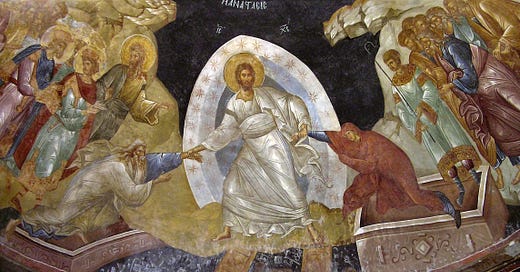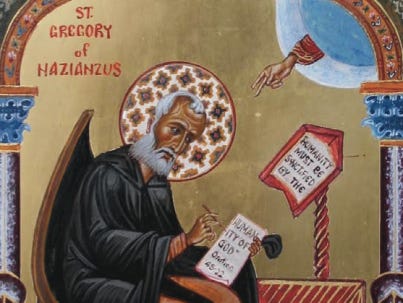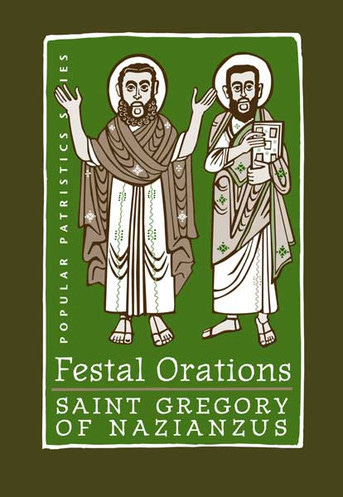

Discover more from Fr. Joe’s Newsletter - Moving to Russia
Jesus Saves by His Incarnation & Resurrection, Not by Ransom to the Father
Jesus did not pay a ransom to God the Father. Jesus did not pay a ransom to the devil. He saves us through the Incarnation, healing our humanity by joining it to deity.
All Christians agree that Jesus died for our sins. But why did He do it? And how does His death bring about our salvation?
During the first millennium, a popular theory was that Jesus died to pay a debt to Satan. This is known as the “Ransom Theory”. A popular modern presentation of this theory is in The Chronicles of Narnia, where Aslan dies as payment to the White Witch, in exchange for the life of Edmund.
In the 12 century, a writer named Anselm openly rejected the Ransom Theory, and popularized a new model known as the “Satisfaction Theory”, which Protestants later augmented into the “Penal Substitutionary Atonement Theory”, presuming, among other things, that Jesus was enduring punishment from God the Father Himself, and that He was thereby paying a debt to God the Father.
The Orthodox Church does not support either of these theories.
In the 4th century, St. Gregory of Nazianzus, one of the great Cappadocian Fathers, in the 22nd section of his Second Oration on Pascha (Easter), explains that Jesus did not save us by paying a ransom to to devil, and He did not save us by paying a ransom to God the Father:
To Whom was that Blood offered that was shed for us, and why was It shed? I mean the precious and famous Blood of our God and High priest and Sacrifice. We were detained in bondage by the Evil One, sold under sin, and receiving pleasure in exchange for wickedness.
Now, since a ransom belongs only to him who holds in bondage, I ask to whom was this offered, and for what cause?
If to the Evil One, fie upon the outrage! If the robber receives ransom, not only from God, but a ransom which consists of God Himself, and has such an illustrious payment for his tyranny, a payment for whose sake it would have been right for him to have left us alone altogether.
But if to the Father, I ask first, how? For it was not by Him that we were being oppressed; and next, on what principle did the Blood of His Only begotten Son delight the Father, Who would not receive even Isaac, when he was being offered by his Father, but changed the sacrifice, putting a ram in the place of the human victim?
Is it not evident that the Father accepts Him, but neither asked for Him nor demanded Him; but on account of the Incarnation, and because Humanity must be sanctified by the Humanity of God, that He might deliver us Himself, and overcome the tyrant, and draw us to Himself by the mediation of His Son, Who also arranged this to the honour of the Father, Whom it is manifest that He obeys in all things?
So much we have said of Christ; the greater part of what we might say shall be reverenced with silence. But that brazen serpent (Numbers 21:9) was hung up as a remedy for the biting serpents, not as a type of Him that suffered for us, but as a contrast; and it saved those that looked upon it, not because they believed it to live, but because it was killed, and killed with it the powers that were subject to it, being destroyed as it deserved. And what is the fitting epitaph for it from us? O death, where is your sting? O grave, where is your victory? You are overthrown by the Cross; you are slain by Him who is the Giver of life; you are without breath, dead, without motion, even though you keep the form of a serpent lifted up on high on a pole.
But if no ransom was paid to the devil, or to God the Father, then how does Jesus save us? According to the Scriptures and the Early Church Fathers, we are not only saved by His death; we are saved by His Incarnation, Birth, Life, Death, Resurrection, and Ascension into Heaven. We are saved by every aspect of the work of Christ, from beginning to end.
St. Irenaeus of Lyons, an Orthodox Saint who lived during the 2nd century, wrote the following in Book 2, Chapter 22, Section 4 of his famous work, Against Heresies:
For he came to save all through means of himself; all I say, who through him are born again to God; infants and children, boys, youths, [adult] men. He therefore passed through every age becoming an infant for infants, thus sanctifying infants; a child for children, thus sanctifying those who are of this age, being at the same time made to them an example of piety, righteousness, and submission; a youth for youths becoming an example to youths, and thus sanctifying them for the Lord… sanctifying at the same time the aged also and becoming likewise an example to them. Then, at the last, He came unto death itself, that he might be the firstborn of the dead, that in all things he might have the preeminence, “the Prince of Life,” existing before all and going before all.
In the Early Church, there is a reason why the Seven Ecumenical Councils focused on the Deity of Christ (“Jesus is truly God”), and on the Incarnation of Christ (“Jesus is truly Man”). It is because this is how Jesus saves us. By joining divinity to humanity within Himself, Jesus heals every aspect of humanity, thereby cleansing us from every sin and every sickness — including mortality itself — and thus saving us to the uttermost.
By becoming an infant, He healed humanity in its infancy.
By becoming a child and a teenager, He healed humanity in its youth.
By becoming an adult, He healed humanity in its maturity.
Through suffering death, He conquered death, and thus healed humanity from death.
By rising from the dead, He ensured that all men will rise from the dead.
By ascending into Heaven in the flesh, humanity is able to follow Him there to Heaven.
In the same Paschal Oration mentioned earlier, St. Gregory of Nazianzus explains that Jesus saves us by joining divinity to humanity within Himself, via the Incarnation:
And that was that the Word of God Himself, Who is before all worlds, the Invisible, the Incomprehensible, the Bodiless, the Beginning of beginning, the Light of Light, the Source of Life and Immortality, the Image of the Archetype, the Immovable Seal, the Unchangeable Image, the Father's Definition and Word, came to His own Image, and took on Him Flesh for the sake of our flesh, and mingled Himself with an intelligent soul for my soul's sake, purifying like by like; and in all points except sin was made Man; conceived by the Virgin… He came forth then, as God, with That which He had assumed; one Person in two natures, flesh and Spirit, of which the latter deified the former. O new commingling; O strange conjunction! The Self-existent comes into Being, the Uncreated is created, That which cannot be contained is contained by the intervention of an intellectual soul mediating between the Deity and the corporeity of the flesh. And He who gives riches becomes poor; for He assumes the poverty of my flesh, that I may assume the riches of His Godhead. He that is full empties Himself; for He empties Himself of His Glory for a short while, that I may have a share in His Fulness. What is the riches of His Goodness? What is this mystery that is around me? I had a share in the Image and I did not keep it; He partakes of my flesh that He may both save the Image and make the flesh immortal.
Since this understanding emphasizes the image of God in man, and the fact that Christ heals, cleanses, and restores this divine image, this understanding is often called the “Restored Icon” model of salvation.
There are some biblical passages which refer to the work of Christ as a “ransom”. However, these passages never say that the ransom was paid to the devil, and these passages do not say that the ransom was paid to God the Father.
When the New Testament Church would read Scripture, they normally used the Septuagint, which is a Greek translation of the Old Testament.
In Exodus 6:6 in Brenton's English translation of the Septuagint, God says, "Go speak to the children of Israel, saying, I am the Lord, and I will lead you forth from the tyranny of the Egyptians, and I will deliver you from bondage, and I will ransom you with a high arm and great judgment." Of course, when the Israelites were freed from Egypt, no ransom payment was made to God, and no ransom payment was made to the devil. On the contrary, the Egyptians gave many of their treasures to the Israelites before they went on their journey. In this case, the word "ransom" simply means "rescue".
The Greek word for "ransom" that is used here in Exodus, is a cognate of the Greek word for "ransom" that is used at various places in the New Testament. So when we read that “Jesus gave His life as a ransom for many” (Mark 10:45), it simply means that Jesus gave His life as a rescue for many. Neither the devil nor God the Father were being "paid".
Our salvation comes primarily through the Incarnation. Jesus joins deity to humanity within Himself, thereby healing humanity. As St. Gregory of Nazianzus explains in his Letter to Cledonius (#101):
"For that which He has not assumed He has not healed; but that which is united to His Godhead is also saved. If only half Adam fell, then that which Christ assumes and saves may be half also; but if the whole of his nature fell, it must be united to the whole nature of Him that was begotten, and so be saved as a whole."
I highly recommend reading the full Second Oration on Pascha in its entirety. It is truly spectacular!
The Orthodox Chrisitian understanding of Christ’s work — the Restored Icon model of salvation — is a beautiful, powerful, and glorious truth. For the next several posts, be on the lookout for more articles on this fascinating topic!

















The more I see of the Orthodox Church the more I like it. That said, as someone growing up in the Protestant tradition I struggle with the icons and confession, although (as I understand it) the latter differs from the Catholic confessional.
In any event, I will look forward to future posts as I think they will continue to open my eyes.
Fr. Joseph, your explanation of ransom as rescue is the missing link in my understanding of salvation. Nothing was paid to Pharoah. Nothing was paid to God. God rescued Israel. The God-man Christ rescues us!! Boom!!! 🤯